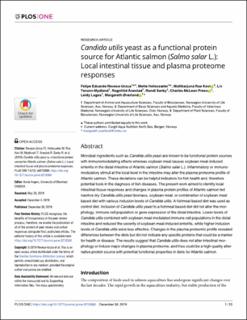| dc.contributor.author | Reveco Urzua, Felipe Eduardo | |
| dc.contributor.author | Hofossæter, Mette Eline | |
| dc.contributor.author | Kovi, Mallikarjuna Rao | |
| dc.contributor.author | Mydland, Liv Torunn | |
| dc.contributor.author | Ånestad, Ragnhild | |
| dc.contributor.author | Sørby, Randi | |
| dc.contributor.author | Press, Charles McLean | |
| dc.contributor.author | Lagos Rojas, Leidy Ximena | |
| dc.contributor.author | Øverland, Margareth | |
| dc.date.accessioned | 2020-10-09T12:03:25Z | |
| dc.date.available | 2020-10-09T12:03:25Z | |
| dc.date.created | 2020-01-08T14:05:12Z | |
| dc.date.issued | 2019 | |
| dc.identifier.citation | PLOS ONE. 2019, 14 (12), . | en_US |
| dc.identifier.uri | https://hdl.handle.net/11250/2682024 | |
| dc.description.abstract | Microbial ingredients such as Candida utilis yeast are known to be functional protein sources with immunomodulating effects whereas soybean meal causes soybean meal-induced enteritis in the distal intestine of Atlantic salmon (Salmo salar L.). Inflammatory or immunomodulatory stimuli at the local level in the intestine may alter the plasma proteome profile of Atlantic salmon. These deviations can be helpful indicators for fish health and, therefore potential tools in the diagnosis of fish diseases. The present work aimed to identify local intestinal tissue responses and changes in plasma protein profiles of Atlantic salmon fed inactive dry Candida utilis yeast biomass, soybean meal, or combination of soybean meal based diet with various inclusion levels of Candida utilis. A fishmeal based diet was used as control diet. Inclusion of Candida utilis yeast to a fishmeal based diet did not alter the morphology, immune cell population or gene expression of the distal intestine. Lower levels of Candida utilis combined with soybean meal modulated immune cell populations in the distal intestine and reduced the severity of soybean meal-induced enteritis, while higher inclusion levels of Candida utilis were less effective. Changes in the plasma proteomic profile revealed differences between the diets but did not indicate any specific proteins that could be a marker for health or disease. The results suggest that Candida utilis does not alter intestinal morphology or induce major changes in plasma proteome, and thus could be a high-quality alternative protein source with potential functional properties in diets for Atlantic salmon. | en_US |
| dc.language.iso | eng | en_US |
| dc.rights | Navngivelse 4.0 Internasjonal | * |
| dc.rights.uri | http://creativecommons.org/licenses/by/4.0/deed.no | * |
| dc.title | Candida utilis yeast as a functional protein source for Atlantic salmon (Salmo salar L.): Local intestinal tissue and plasma proteome responses | en_US |
| dc.type | Peer reviewed | en_US |
| dc.type | Journal article | en_US |
| dc.description.version | publishedVersion | en_US |
| dc.source.pagenumber | 22 | en_US |
| dc.source.volume | 14 | en_US |
| dc.source.journal | PLOS ONE | en_US |
| dc.source.issue | 12 | en_US |
| dc.identifier.doi | 10.1371/journal.pone.0218360 | |
| dc.identifier.cristin | 1768641 | |
| dc.relation.project | Norges forskningsråd: 237841 | en_US |
| dc.relation.project | Norges forskningsråd: 239003 | en_US |
| cristin.unitcode | 192,10,1,0 | |
| cristin.unitcode | 192,16,1,0 | |
| cristin.unitcode | 192,10,2,0 | |
| cristin.unitname | Institutt for husdyr- og akvakulturvitenskap | |
| cristin.unitname | Institutt for basalfag og akvamedisin | |
| cristin.unitname | Institutt for plantevitenskap | |
| cristin.ispublished | true | |
| cristin.fulltext | original | |
| cristin.qualitycode | 1 | |

